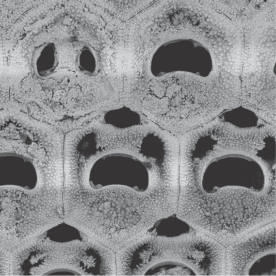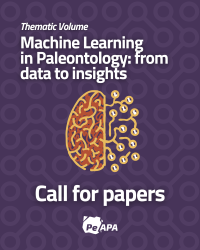SPECIES OF THE GENUS MELICERITA MILNE EDWARDS (BRYOZOA, CHEILOSTOMATIDA) IN THE EARLY MIOCENE OF PATAGONIA (ARGENTINA)
DOI:
https://doi.org/10.5710/PEAPA.15.02.2023.448Keywords:
Cellariidae, Monte León Formation, Chenque Formation, ArgentinaAbstract
Species of the cellariid genus Melicerita Milne Edwards develop bilaminar flattened colonies consisting of alternate transverse rows of hexagonal zooids. In South America, its stratigraphic range extends from the early Miocene to the Recent. Re-examination of the type material of M. triforis Ortmann from the Monte León Formation at Río Chalía, and scanning electron microscope images of M. ortmanni Canu from the early Miocene Chenque Formation, confirmed that the latter is a junior synonym of M. triforis. Vicarious avicularia are described for the first time in M. triforis. Lectotypes are herein chosen for both nominal species. M. imperforata sp. nov. is described from material obtained in Monte León Formation (early Miocene). It differs from all known Melicerita species in the size and shape of its vicarious avicularia, which are marginal and much larger than the autozooids. The Recent Magellanic species M. temaukeli Moyano and M. blancoae López Gappa share morphological similarities with M. triforis.
References
Androsova, E. I. (1972). Marine invertebrates from Adelie Land, collected by the XIIth and XVth French Antarctic Expeditions. 6. Bryozoa. Tethys, supplement 4, 87–102.
Bader, B. & Schäfer, P. (2004). Skeletal morphogenesis and growth check lines in the Antarctic bryozoan Melicerita obliqua. Journal of Natural History, 38(22), 2901–2922. https://doi.org/10.1080/00222930310001657685
Brey, T., Gutt, J., Mackensen, A. & Starmans, A. (1998). Growth and productivity of the high Antarctic bryozoan Melicerita obliqua. Marine Biology, 132, 327–333. https://doi.org/10.1007/s002270050398
Brown, D. A. (1952). The Tertiary cheilostomatous Polyzoa of New Zealand. The Trustees of the British Museum, London.
Brown, D. A. (1954). Polyzoa from a submerged limestone off the Three Kings Islands, New Zealand. Annals and Magazine of Natural History, series 12, 7, 415–437.
Brown, D. A. (1958). Fossil cheilostomatous Polyzoa from south-west Victoria. Memoirs of the Geological Survey of Victoria, 20, 7–90.
Busk, G. (1852). An account of the Polyzoa, and sertularian zoophytes, collected in the Voyage of the Rattlesnake, on the coasts of Australia and the Louisiade Archipelago. In J. MacGillivray (Ed.), Narrative of the Voyage of the H.M.S. Rattlesnake (pp. 343–402). T. & W. Boone, London.
Busk, G. (1884). Report on the Polyzoa collected by H.M.S. Challenger during the years 1873–1876, Part 1. The Cheilostomata. Report on the Scientific Results of the Voyage of H.M.S. Challenger, Zoology, 10, 1–216.
Canu, F. (1908). Iconographie des bryozoaires fossiles de l´Argentine. Première partie. Anales del Museo Nacional de Buenos Aires, serie 3, 10, 245–341.
Cook, P. L., Bock, P. E., Hayward, P. J. & Gordon, D. P. (2018) Class Gymnolaemata, Order Cheilostomata. In P. L. Cook, P. E. Bock, D. P. Gordon, & H. J. Weaver (Eds.), Australian Bryozoa, Volume 2, Taxonomy of Australian Families (314 pp.). CSIRO Publishing, Melbourne.
Cuitiño, J. I., Raigemborn, M. S., Bargo, M. S., Vizcaíno, S. F., Muñoz, N. A., Kohn, M. J. & Kay, R. F. (2021). Insights on the controls on floodplain-dominated fluvial successions: a perspective from the Early–Middle Miocene Santa Cruz Formation in Río Chalía (Patagonia, Argentina). Journal of the Geological Society, 178(4), 1–20. https://doi.org/10.1144/jgs2020-188
Cuitiño, J. I., Ventura Santos, R., Alonso Muruaga, P. J. & Scasso, R. A. (2015). Sr-stratigraphy and sedimentary evolution of early Miocene marine foreland deposits in the northern Austral (Magallanes) Basin, Argentina. Andean Geology, 42(3), 364–385. http://dx.doi.org/10.5027/andgeoV42n3-a05
De Blauwe, H. & Gordon, D. P. (2014). New bryozoan taxa from a biodiversity hotspot in the Eastern Weddell Sea. Studi Trentini di Scienze Naturali, 94, 53–78.
Figuerola, B., Gordon, D. P. & Cristobo, J. (2018). New deep Cheilostomata (Bryozoa) species from the Southwestern Atlantic: shedding light in the dark. Zootaxa, 4375(2), 211–249. https://doi.org/10.11646/zootaxa.4375.2.3
Fleming, J. (1828). A history of British animals, exhibiting their descriptive characters and systematic arrangement of the genera and species of quadrupeds, birds, reptiles, fishes, Mollusca, and Radiata of the United Kingdom. Bell & Bradfute, Edinburgh.
Gordon, D. P. (1986). The marine fauna of New Zealand: Bryozoa: Gymnolaemata (Ctenostomata and Cheilostomata Anasca) from the western South Island continental shelf and slope. New Zealand Oceanographic Institute Memoir, 95, 1–121.
Gutt, J., Sirenko, B. I., Arntz, W. E., Smirnov, I. S. & De Broyer, C. (2000). Biodiversity of the Weddell Sea: Macrozoobenthic species (demersal fish included) sampled during the expedition ANT XIII/3 (EASIZ I) with RV "Polarstern". Berichte zur Polarforschung, 372, 1–103. https://doi.org/10.2312/BzP_0372_2000
Hayward, P. J. (1995). Antarctic cheilostomatous Bryozoa. Oxford University Press, New York.
Hayward, P. J. & Thorpe, J. P. (1989). Membraniporoidea, Microporoidea and Cellarioidea (Bryozoa, Cheilostomata) collected by Discovery Investigations. Journal of Natural History, 23(4), 913–959. https://doi.org/10.1080/00222938900770481
Hayward, P. J. & Winston, J. E. (1994). New species of cheilostomate Bryozoa collected by the US Antarctic Research Program. Journal of Natural History, 28, 237–246. https://doi.org/10.1080/00222939400770101
Hondt, J.-L. d’ (1984). Nouvelle contribution à la connaisance des bryozoaires marins des terres australes françaises. Comité National Française des Recherches Antarctiques, 55, 95–116.
Hondt, J.-L. d’ (1985). Contribution à la systématique des Bryozoaires Eurystomes. Apports récents et nouvelles propositions. Annales des Sciences Naturelles, Zoologie (série 13), 7, 1–12.
Hondt, J.-L. d’ & Gordon, D. P. (1999). Entoproctes et bryozoaires cheilostomida (Pseudomalacostegomorpha et Cryptocystomorpha) des campagnes MUSORSTOM autour de la Nouvelle-Calédonie. Mémoires du Muséum National d’Histoire Naturelle, 180, 169–251.
Key, Jr M. M., Rossi, R. K., Smith, A. M., Hageman, S. J. & Patterson, W. P. (2018). Stable isotope profiles of skeletal carbonate validate annually-produced growth checks in the bryozoan Melicerita chathamensis from Snares Platform, New Zealand. Bulletin of Marine Science, 94(4), 1447–1464. https://doi.org/10.5343/bms.2017.1166
Liu, X. & Hu, Y. (1991). On the cheilostome bryozoans from the northwest waters off the Antarctic peninsula. Studia Marina Sinica, 32, 7–160.
Livingstone, A. A. (1928). The Bryozoa, Supplementary Report, The Australian Antarctic Expedition, 1911-1914. Scientific reports of the Australian Antarctic Expedition 1911-1914, Series C, Zoology and Botany, 9, 1–93.
López de la Cuadra, C. M. & García Gómez, J. C. (2000). The cheilostomate Bryozoa (Bryozoa: Cheilostomatida) collected by the Spanish ‘Antártida 8611’ expedition to the Scotia Arc and South Shetland Islands. Journal of Natural History, 34, 755–772.
López Gappa, J. (1981). Una nueva especie de Melicerita de la plataforma patagónica (Bryozoa Cheilostomata). Neotropica, 27(78), 127–131.
MacGillivray, P. H. (1895) A monograph of the Tertiary Polyzoa of Victoria. Transactions of the Royal Society of Victoria, 4, 1–166.
Malumián, N. (1999). La sedimentación y el volcanismo terciarios en la Patagonia extraandina. 1. La sedimentación en la Patagonia extraandina. In R. Caminos (Ed.), Geología Argentina (pp. 557–612). Servicio Geológico Minero Argentino, Instituto de Geología y Recursos Minerales, Anales, 29.
Milne Edwards, H. (1836). Sur un nouveau genre de polypiers fossiles, de la famille des Escharines, nomme Mélicerite. Annales des Sciences naturelles, Zoologie & Biologie animale, 6, 345–347.
Morris, J. (1843). A catalogue of British fossils (pp. 1–374). J. Van Voorst, London.
Moyano, H. I. (1968). Distribución y profundidades de las especies exclusivamente antárticas de Bryozoa Cheilostomata recolectadas por la decimonovena Expedición Antártica Chilena 1964–65. Boletín de la Sociedad de Biología de Concepción, 40, 113–123.
Moyano, H. I. (1969). Bryozoa colectados por la Expedición Antártica Chilena 1964–65. III. Familia Cellariidae Hincks, 1880. Boletín de la Sociedad de Biología de Concepción, 41, 41–77.
Moyano, H. I. (1997a). Las especies chilenas de Melicerita (Bryozoa, Cellariidae) con la descripción de una nueva especie. Gayana Zoología, 61(1), 49–55.
Moyano, H. I. (1997b). Revisión de la diversidad y de las conexiones zoogeográficas de los briozoos magallánicos. Gayana Zoología, 61(2), 125–139.
Moyano, H. I. (2000). Bryozoa from the Magellanic continental slope near Cape Horn: an unexpected collection. In A. Herrera Cubilla, & J. B. C. Jackson (Eds.), Proceedings of the 11th International Bryozoology Association Conference (pp. 298–304). Smithsonian Tropical Research Institute, Balboa.
Ortmann, A. E. (1900). Synopsis of the collections of invertebrate fossils made by the Princeton Expedition to southern Patagonia. American Journal of Science, series 4, 10, 368–381.
Ortmann, A. E. (1902). Paleontology Part II. Tertiary invertebrates. In W. B. Scott (Ed.), Reports of the Princeton University Expeditions to Patagonia, 1896-1899. Vol 4 Paleontology I, part 2. (pp. 45–332). J. Pierpont Morgan Publication Fund, Princeton.
Parras, A. M. & Cuitiño, J. I. (2018). The stratigraphic and paleoenvironmental significance of the regressive Monte Observación Member, early Miocene of the Austral-Magallanes Basin, Patagonia. Latin American Journal of Sedimentology and Basin Analysis, 25(5), 93–115.
Parras, A., Dix, G. R. & Griffin, M. (2012). Sr-isotope chronostratigraphy of Paleogene–Neogene marine deposits: Austral Basin, southern Patagonia (Argentina). Journal of South American Earth Sciences, 37, 122–135. https://doi.org/10.1016/j.jsames.2012.02.007
Parras, A., Guerstein, G. R., Pérez Panera, J. P., Griffin, M., Náñez, C., Cusminsky, G. & Quiroga, A. (2020) Integrated stratigraphy and paleontology of the lower Miocene Monte León Formation, southeastern Patagonia, Argentina: Unraveling paleonvironmental changes and factors controlling sedimentation. Palaeogeography, Palaeoclimatology, Palaeoecology, 556, 109701.
https://doi.org/10.1016/j.palaeo.2020.109701
Perez, F. M. & Banta, W. C. (1996). How does Cellaria get out of its box? A new cheilostome hydrostatic mechanism (Bryozoa: Cheilostomata). Invertebrate Biology, 115, 162–169.
Powell, N. A. (1969). The occurrence of Melicerita angustiloba Tenison-Woods (Bryozoa-Cellariidae) in New Zealand offshore waters. Transactions of the Royal Society of New Zealand, Biological Sciences, 11, 201–204.
Ramalho, L. V., López-Gappa, J. & Scarabino, F. (2022). Checklist of the marine Bryozoa from Uruguay (Southwest Atlantic). Revista del Museo Argentino de Ciencias Naturales, nueva serie, 24(1), 109–134. http://dx.doi.org/10.22179/revmacn.24.722
Rogick, M. D. (1956). Bryozoa of the United States Navy’s 1947–1948 Antarctic Expedition, I–IV. Proceedings of the United States National Museum, 105, 221–317.
Rosso, A. (1992). Melicerita digeronimoi sp. nov.: A new Antarctic bryozoan. Boletín de la Sociedad de Biología de Concepción, 63, 185–192.
Souto, J. & Albuquerque, M. (2019). Diversity and community structure of Cheilostomata (Bryozoa) from the Hayes Fracture Zone, Mid-Atlantic ridge. Deep Sea Research Part I: Oceanographic Research Papers, 147, 32–53. https://doi.org/10.1016/j.dsr.2019.03.006
Tenison Woods, J. E. (1862). Geological observations in South Australia. Longman, Green, Longman, Roberts & Green, London.
Thornely, L. R. (1924). Polyzoa. Scientific Reports of the Australian Antarctic Expedition 1911-1914, Series C, Zoology and Botany, 6, 1–23.
Uttley, G. H. & Bullivant, J. S. (1972). Biological results of the Chatham Islands 1954 expedition. Part 7. Bryozoa Cheilostomata. New Zealand Oceanographic Institute Memoir, 57(7), 9–59.
Vieira, L. M., Gordon, D. P., Souza, F. B. C. & Haddad, M. A. (2010). New and little-known cheilostomatous Bryozoa from the south and southeastern Brazilian continental shelf and slope. Zootaxa, 2722(1), 1–53. https://doi.org/10.11646/zootaxa.2722.1.1
Vigeland, I. (1952). Antarctic Bryozoa. Scientific Results of the Norwegian Antarctic Expeditions, 1927–1928, 34, 1–15.
Wass, R. E. & Yoo, J. J. (1983). Cheilostome Bryozoa from the Southern Australian Continental Shelf. Australian Journal of Marine and Freshwater Research, 34(2), 303–354. https://doi.org/10.1071/MF9830303
Waters, A. W. (1882a). On fossil chilostomatous Bryozoa from Mount Gambier, South Australia. Quarterly Journal of the Geological Society of London, 38, 257–276.
Waters, A. W. (1882b). On chilostomatous Bryozoa from Bairnsdale (Gippsland). Quarterly Journal of the Geological Society of London, 38, 502–513.
Waters, A. W. (1883). Fossil chilostomatous Bryozoa from Muddy Creek, Victoria, etc. Quarterly Journal of the Geological Society of London, 39, 423–443.
Winston, J. E. (1983). Patterns of growth, reproduction and mortality in bryozoans from the Ross Sea, Antarctica. Bulletin of Marine Science, 33(3), 688–702.

Downloads
Published
Issue
Section
License
Copyright (c) 2023 Juan López Gappa, Leandro Martín Perez

This work is licensed under a Creative Commons Attribution-NoDerivatives 4.0 International License.
Authors retain copyright and grant the journal right of first publication with the work simultaneously licensed under a Atribución/Reconocimiento 4.0 Internacional that allows others to share the work with an acknowledgement of the work's authorship and initial publication in this journal.
















